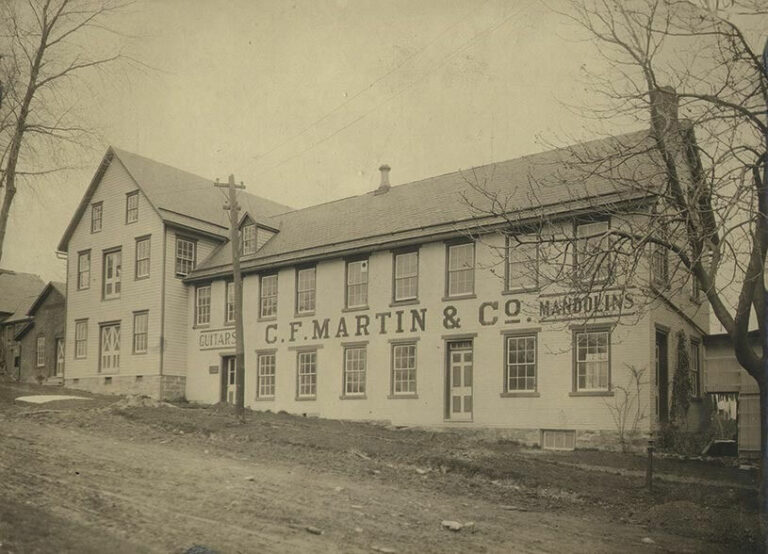The Enduring Legacy of Martin Guitars: 190 Years of Craftsmanship and Innovation
In 1833, a young German immigrant named Christian Frederick Martin established a small guitar-making workshop in New York City. Nearly two centuries later, Martin & Co. has evolved into America’s oldest and most storied acoustic guitar manufacturer. Through six generations of family ownership, two world wars, depressions, and rock revolutions, Martin has continued to make some of the world’s finest stringed instruments.
Martin’s legacy stretches back to late 18th century Germany, where company founder C.F. Martin apprenticed under renowned luthier Johann Stauffer. After honing his craftsmanship, Martin returned home only to become embroiled in a dispute between instrument-making guilds over who had the rights to construct the then relatively new invention – the guitar. This guild conflict, coupled with his father’s death, compelled Martin to seek better fortunes across the Atlantic.
Arriving in New York City in 1833, Martin established his small workshop on Hudson Street in Lower Manhattan. At his wife’s urging, they relocated the growing business to Nazareth, Pennsylvania just five years later in 1838. The move proved fortuitous, positioning Martin Guitars in the heart of Pennsylvania’s rich woodworking region.
Martin even played an inadvertent role in birthing metal and grunge. While the Stinger – Martin’s troubled 1980s foray into electric guitars – was quickly discontinued, Nirvana’s Kurt Cobain often played a Stinger onstage in Nirvana’s early days. Cobain later revisited his acoustic roots by playing a Martin dreadnought for his famed MTV Unplugged performance shortly before his death.
Today, after 190 years, Martin continues to push acoustic guitar design into the future while honoring their time-tested craft. Innovations like the radically asymmetrical, electric-inspired SC-13E show they still have surprises up their sleeve, while collaborations with edgy artists like Chris Stapleton demonstrate Martin still has its finger on the pulse of music culture.
Yet through nearly two centuries of revolutions and reinventions, Martin has proudly held onto the traditions of quality materials and meticulous workmanship handed down through six generations of family ownership.
For instance, over 20 Martin craftspeople hand-shape the company’s iconic necks, while some 300 hands touch each instrument during the two months it takes to construct a single guitar. Even as computer-guided laser cutters create perfectly cut inlays with precision, master craftspeople still manually install each fret. Atop tone-enhancing scalloped X-bracing patterns, table tops are still planed and sanded by hand. And before any instrument receives its voice through careful stringing and tuning, seasoned specialists individually play-test its notes up and down the neck.
This blend of timeless hand-craftsmanship and modern technology has allowed Martin to remain at the pinnacle of American acoustic guitar-making for nearly two centuries. Even amidst constantly evolving music cultures and production methods, Martin manages to blend progress and tradition into instruments with eternal playability.
Whether conjuring cowboy songs or protest anthems, grunge angst or folk revival fervor, a Martin guitar has been there time and again. As long as handcrafted instruments are valued and songwriting is an artform, the Martin legacy will endure.
Frequently Asked Questions
What was the first Martin guitar model?
The earliest Martin guitars produced in the 1830s were Stauffer-style instruments based on designs C.F Martin learned from his mentor in Europe. The first original Martin model was the Martin 0-14 Fret, introduced in 1845.
Who invented the Dreadnought guitar?
The Dreadnought guitar body shape was designed at Martin Guitars in 1916. However, it did not achieve popularity until redesigned with X-bracing in 1931.
What makes pre-World War II Martin guitars so valuable?
Pre-war Martins from the 1930s and earlier are prized for their craftsmanship, materials like Adirondack spruce tops and Brazilian rosewood backs/sides, and unique X-bracing patterns. These factors give them a highly resonant, rich tone.
Which famous musicians play Martin guitars?
Martin guitars have been played by Hank Williams, Elvis Presley, Bob Dylan, John Lennon, David Gilmour, Eric Clapton, Kurt Cobain, Ed Sheeran, and countless other major artists spanning all genres.
Is Martin still a family-owned company?
Yes, Martin Guitars has remained family-owned and operated for 6 generations, since Christian Frederick Martin founded it in 1833. The current Chairman and CEO is Christian Frederick Martin IV.
Learn More About Martin Guitars
January 27, 2024
A Guitar Lover’s Guide to Visiting Martin Guitars in Nazareth, PA
Read Now
January 30, 2024
Design Your Dream Guitar with Martin Custom Shop
Read Now
January 12, 2024
Handmade Matters – The Artistry and Craftsmanship Behind Martin Guitars
Read Now
January 30, 2024
Martin Guitar Unveils Exciting New Models for 2024 at NAMM Show
Read Now



Worked at Martin guitar 🎸 for 20yrs and enjoyed the interaction with fellow employees and awesome paycheck and quality of instruments
The sound and playability of martin guitars is top notch . Quality control on finishes and binding issues not so much . My Luthier makes bank fixing newer martin binding separations all the time . I bought a new Hd28 last December and as soon as I got it home and started playing it the side cracked on the lower bought . The store replaced it instantly and Ive noticed some rough spots on the edge of the fret board and bridge like file marks . The finish is sunburst and hazes awful where I touch it . O erall it love my Martins but quality control needs help . And please spray finish over binding and use a better glue ,I know it’s hard to get plastic to stick to wood maybe just offer some models with wood binding?